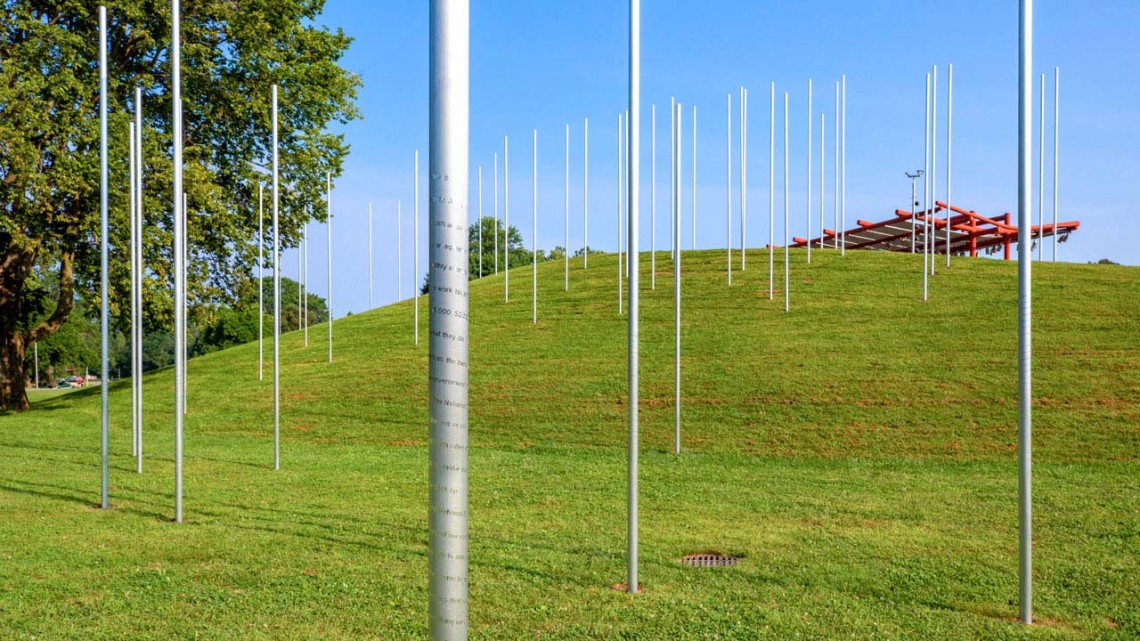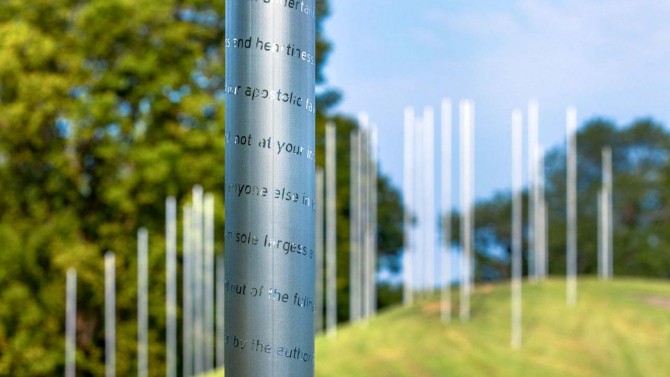
Two Cornell architecture professors, Jennifer Newsom and Tom Carruthers, created “Columbus Columbia Colombo Colón” at Mill Race Park in Columbus, Indiana, to thoughtfully address colonialism. The 58 poles of the art installation are arranged geographically to form a map from above.
Columbus art explores the world’s entrenched colonialism
By Blaine Friedlander
At Mill Race Park in Columbus, Indiana, text on a silver flagpole tells of Horace King, a black enslaved architect and engineer who successfully built the first bridge – in 1833 – that crossed the Chattahoochee River from Columbus, Georgia, into Alabama.
Nearby, 57 other poles tell more narratives and offer reflections on places around the world named directly or indirectly for Christopher Columbus. It’s not all flattering.
Together the poles make up the outdoor art installation, “Columbus Columbia Colombo Colón,” now on display until Nov. 28. It connects places around the world named for Columbus to prompt contemplation; it was designed and built by faculty members Jennifer Newsom and Tom Carruthers, from Cornell’s College of Architecture, Art and Planning.
“In the Columbus name, you see an oscillation between a thing and an action,” said Newsom, an assistant professor. “The installation ‘Columbus, Columbia, Columbia Colón’ is stating the obvious: There is a kind of entrenched colonial presence in North and South America that extends to influence the entire world.
“The installation is trying to speak to the multiplicity of ways in which we contend with these historical trajectories that also are very evident in the present day,” Newsom said. “These are all marking current place names in the landscape.”
The city of Columbus, Indiana, located between Indianapolis and Lexington, Kentucky, boasts a notable hotbed of architectural and artistic verve. The city is awash in buildings designed by famous architects: I.M. Pei created the Cleo Rogers Memorial Library, while Gunnar Bikerts designed the town’s Lincoln Elementary School and Saint Peter’s Lutheran Church. The town’s fire stations were designed by Robert Venturi, William Burd, Leighton Bowers, Susana Torre and William Rawn.
Carruthers and Newsom – the principals in the architectural firm Dream the Combine – won the 2021 J. Irwin and Xenia S. Miller Prize; with the prize came the opportunity to design a piece of public art.
Given the scale of Columbus, Indiana, as a city, Newsom and Carruthers related the Columbus name to the civic environment. “‘Columbus’ was kind of a poem and a metaphor,” said Carruthers, a professor of the practice. “It is a crater on Mars, a space shuttle, a module on the International Space Station, a movie, a backstory, an opera, a television network, a sausage company, a bike frame, a bus system, a sculpture, a cruise ship. It becomes so synonymous, so what does ‘Columbus’ actually mean?”
For example, Newsom points out that the installation’s District of Columbia pole features a poem by Phillis Wheatley, a well-known, enslaved Revolutionary War-era poet born in West Africa, who first linked the female embodiment of Columbia to the United States.
The exhibit’s 58 flag poles bring out the “spiral text” of stories, counterpoints and metaphors to induce a dizzying reading movement, that has a choregraphed, performative aspect, said Carruthers.
“We are encouraging people to get inside the installation, to learn and to move through the texts,” Newsom said.
On the Columbus, Georgia, pole, the installation notes Horace King later bought his own freedom and established a successful bridge building company. “Horace King’s life soars above the murky waters of historical limitations, of human bondage and racial prejudice,” the pole’s text notes, quoting King’s eulogy. “He did not change the currents of social history, but he did transcend them.”
Media Contact
Get Cornell news delivered right to your inbox.
Subscribe

